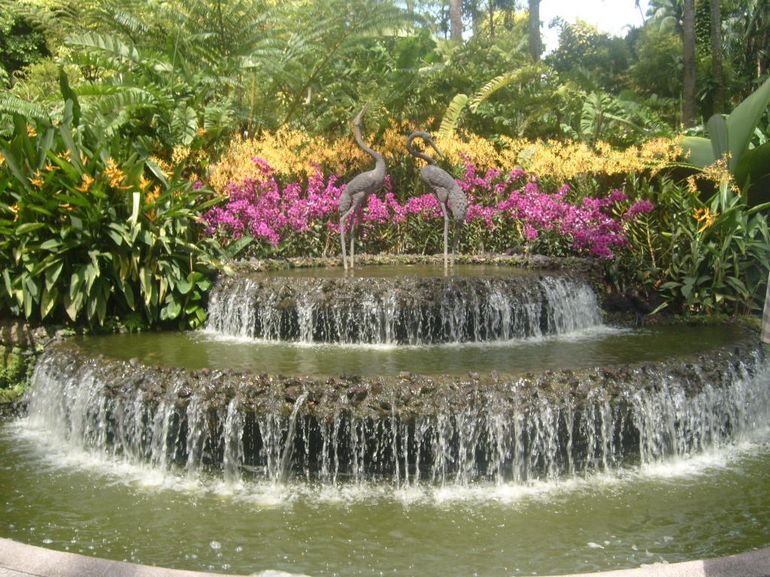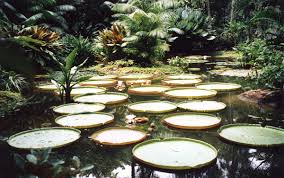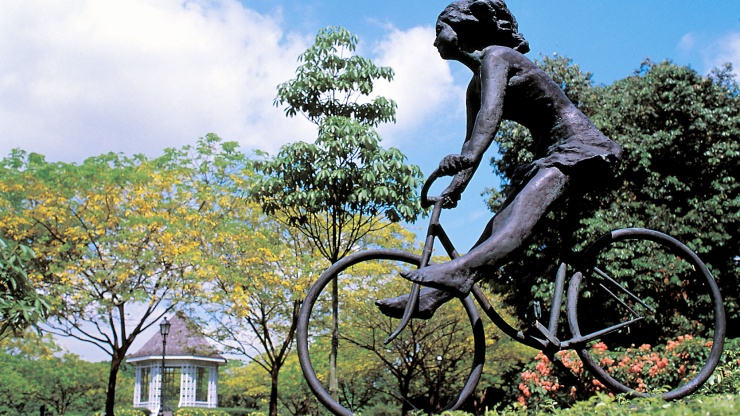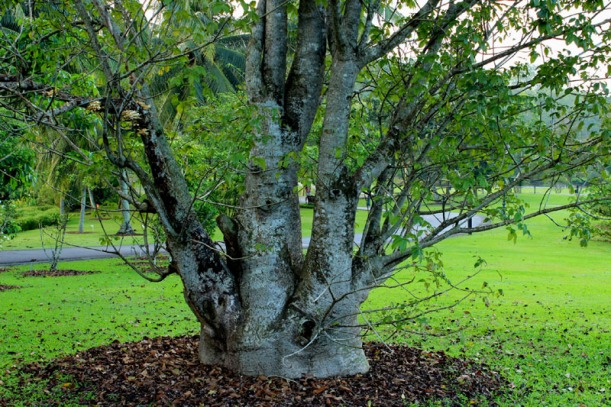In search of the baobab
Chasing a childhood chimera, Sheila Kumar walks through Singapore's beautiful Botanical Gardens
|

I blame it all on Antoine de St Exupery and his "The Little Prince."
Ever since I read that classic, I've been wanting to see a baobab
tree. And when someone I met at Singapore's Tony Tanglin
Club mentioned a baobab tree in the Lion City's Botanical
Gardens, I, of course, just had to set off on a pilgrimage.
Which was how I ended walking virtually all of the 52 well
laid out hectares of the Gardens, not that I regret it for a
moment.
Like everything else in Singapore, The Gardens have clear
signposts all along the wooded trails, telling you what lies
ahead and ensuring you don't get lost for a minute. Then
again, I discovered that getting lost could be a lot of fun,
too. Since my informant was at best vague about the
baobab tree, I decided to stroll the Gardens looking
for the tree but taking in whatever else came my
way, besides.
Lush parks
The Singapore Botanical Garden was established way back
in 1822 by Sir Stamford Raffles himself but that was at
Fort Canning; the Gardens were laid out at their present
site in 1859. Once a centre for agricultural experimentation,
now the Gardens are parks for walking, jogging, picnicking;
popular, though more among the locals than tourists.
Which is very definitely a tourist's loss.

The gardens are known for their famous sub-section, the Orchid
Gardens, and the blooms, growing and on display there, are
a staggering riot of size, species and colour, some distinctly
sinister in aspect. Orchid breeding began here in 1928 and
today, the Orchid Garden houses over a 1,000 species and
2,000 hybrids, the largest display of the bloom in all the world.
The lovely, colonial Burkhill Mansion houses the VIP Orchids,
named after famous leaders, statesmen and other visiting
celebrities. I looked for the bloom named after Shah Rukh
Khan but was told it was brought out only when it flowered.
The Cool House, the Green House and the Mist House all
held exquisite specimen of tropical plants and flowers, some
from the mountainous areas.
My search for the elusive baobab led me down some pretty
paths, indeed; green arbours, heliconia-hedged downs, leafy
walks, the structured topography contrasting beautifully
with the tropical jungle backdrop. The local jacaranda
was in season and some pathways were carpeted
lushly in yellow flowers. Frangipani trees, too, dropped
their pink-tinged white flowers, as did the laburnum,
while rain trees spread their fan-like branches overhead,
shielding walkers from the sun. Not too far on the
horizon, I could glimpse the busy buildings of Orchard
Road but the Gardens had muffled all sounds of traffic.
I came across a couple of lily ponds surrounded by statuary
that seemed to belong to no definite culture or period but
just looked pretty; a set of lovely lakes (Swan Lake, Eco
Lake, Symphony Lake), the first with white and black swans
duly strutting their stuff on the waters; a white wooden
pavilion, the Bandstand.
 Palms of many kinds fanned out in all their glory in the
Palms of many kinds fanned out in all their glory in the
Palm Walk. One beautiful kind was the sealing wax palm with
vibrant red stems, the exact scarlet of sealing wax. Turning
down a pebble path, I came to Singapore's national flower,
the Agnes Joaquim, rows upon rows of orchids with elongated
stalks and pale pink flowers. A Chinese gentleman had
pulled up a mobile stool and was standing precariously on it,
staring closely at the blooms.
Varied walks
Deep in the Gardens, I came across a most charming
sight... a set of statues of women, a girl on a hammock,
another on a swing, a third on a bicycle, all free form
sculptures full of grace and fluidity, all executed by
Sydney Harpley.
 The Rain Forest, which predates the Gardens, was intriguingly
The Rain Forest, which predates the Gardens, was intriguingly
full of forest sounds, the chirping of birds, the chirruping
of crickets, and one actually expected to come face to
face with some minor denizen of the jungle. One delightful
thing is that pets (on a leash, of course) are allowed into the
Gardens, so one saw a whole lot of cute pooches, noble
hounds, collies, Maltese, Yorkies and sundry cats, too.
The Cactus Garden had some striking specimen of hardy
succulents on a bed of sand. The Ginger Garden hosted as
many as 250 varieties of ginger and its `relatives.'
 A walk through the ages
A walk through the ages
Further on, I walked barefoot on the Reflexology Path, no mean
feat as the sun had warmed the smooth pebbles by then,
and came to the Evolution Garden. Here, one walked through
the ages, gazing upon plants, fossils, trees while reading
up on neat potted accounts of the evolution of the species,
of human, fauna, flora, rocks.
The Gardens have toilets placed at convenient intervals;
a couple of quick bite eateries, two restaurants (one the
famous Au Jardin Les Amis, where you need to queue up
for reservations); and of course, the ubiquitous gift shops.
My baobab hunt, you ask? I looked high, I looked low, but
found nary a baobab tree. Two evenings later, I ran into
my `baobab informant.' Didn't you see it at the cactus
garden, he asked with insouciance. And on closer questioning,
admitted he wasn't sure what he'd seen was a baobab tree,
it just looked like what he imagined one to be. The only
reason I did him no physical harm was because I'd so
enjoyed my trawl of the Botanical Gardens.
http://www.hindu.com/mp/2006/06/26/stories/2006062600080200.htm
| 
